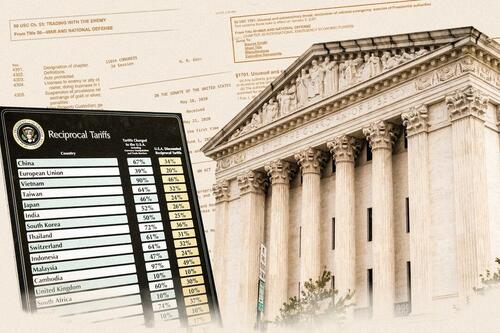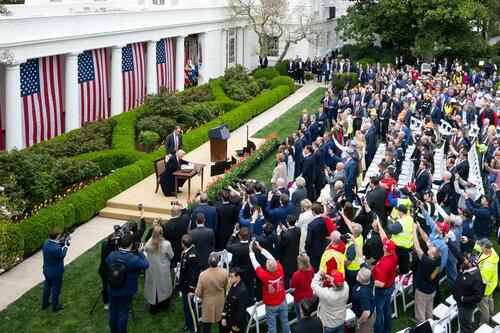Things Aren't Looking Great For Trump In Supreme Court Tariff Arguments
Odds of the Supreme Court siding with Trump over tariffs tumbled on Wednesday, after conservative justices Kavanaugh, Gorsuch, and Coney Barrett asked tough questions during oral arguments in two cases.
After the first hour of argument, the Trump administration's case justifying tariffs looked to be in serious trouble - specifically his claim that a 1977 economic emergency law grants the president unilateral power to impose tariffs at will.
Chief Justice John Roberts, Justice Neil Gorsuch and other conservatives raised against Solicitor General John Sauer one of the legal principles they used to strike down big priorities for the Biden administration: the Major Questions Doctrine, which holds that the executive can’t find extraordinary powers in statutes that don’t contemplate major policy changes. -WSJ
More:
That said, the Trump admin has a plan if things don't go their way with the Supremes.
As the WSJ notes;
Trump's team for months has weighed using other laws as contingency plans to replace the Ieepa tariffs if they lose in court. That includes potentially deploying a never-before used provision in the Trade Act of 1974-Section 122- which allows for tariffs of up to 15% for 150 days to address trade imbalances with other countries. That would buy time for Trump to devise individualized tariffs for each major trading partner under a different provision of the same law, Section 301, which is used to counter unfair foreign trade practices.
That plan could be more legally defensible. The U.S. Court of International Trade, which ruled against Trump's tariffs, pointed to Section 122 as a more reasonable legal defense for global tariffs. Section 301, meanwhile, has long been used to address unfair foreign trade practices, and was deployed to underpin Trump's first-term tariffs on China. Additionally, the administration could also seek to use Section 338 of the Tariff Act of 1930, which allows the president to impose tariffs up to 50% on nations that discriminate against U.S. commerce.
The clawbacks here are going to be a shitshow...
* * *
Authored by Sam Dorman via The Epoch Times (emphasis ours),
The Supreme Court is set to hear oral arguments on Nov. 5 in a landmark case over the legality of President Donald Trump’s global tariffs.
 Illustration by The Epoch Times, Getty Images, Madalina Kilroy/The Epoch Times
Illustration by The Epoch Times, Getty Images, Madalina Kilroy/The Epoch TimesMore specifically, the justices are expected to hear two cases—Learning Resources, Inc. v. Trump, and Trump v. V.O.S. Selections, Inc.—for at least 80 minutes with input from various parties. According to the court, oral arguments will include 40 minutes from the Trump administration and 20 minutes each for both the private businesses and states challenging Trump’s policy.
Whatever the ruling, the case could have major implications for the nation’s economy and determine how much future presidents can alter trade. Here’s what you need to know heading into oral arguments.
1. What Are the Cases About?The cases center on two groups of tariffs that the Trump administration imposed earlier this year. One group targeted Mexico, Canada, and China over their alleged failure to address fentanyl trafficking, and the other set included a lengthy list of reciprocal tariffs on countries worldwide.
The tariffs were imposed under a 1977 emergency powers law—the International Emergency Economic Powers Act. Trump is the first president to impose tariffs under this law, although President Richard Nixon used an identical provision in a predecessor law in 1971—the Trading with the Enemy Act of 1917—to declare a trade emergency and issue 10 percent tariffs on all imports.
Trump established the fentanyl tariffs in February in response to the three countries’ failure to stem the flow of illegal opioids into the United States, which created a national emergency, including a public health crisis, according to his executive orders.
The president cited the hundreds of thousands of overdose deaths of Americans and the drug crisis’s impact on the health care system, communities, and families. Mexico and Canada were also penalized for failing to stem illegal immigration.
In enacting the reciprocal tariffs in April, Trump declared an emergency over large and persistent U.S. trade deficits caused by decades of unfair trade practices by other countries in the form of tariffs and nontariff barriers.
The persistent trade imbalance has threatened national and economic security, Trump’s executive order states, by hollowing out the country’s manufacturing capacity, undermining critical supply chains, and causing the defense industry to be dependent on foreign adversaries.
 Trucks enter the United States from Canada at the Pacific Highway Port of Entry in Blaine, Wash., on Feb. 1, 2025. Earlier this year, the Trump administration imposed 25 percent tariffs on Mexico and Canada. The Supreme Court will hear arguments on Nov. 5 in a landmark case over the legality of the administration’s global tariffs. David Ryder/Getty Images2. The Stakes
Trucks enter the United States from Canada at the Pacific Highway Port of Entry in Blaine, Wash., on Feb. 1, 2025. Earlier this year, the Trump administration imposed 25 percent tariffs on Mexico and Canada. The Supreme Court will hear arguments on Nov. 5 in a landmark case over the legality of the administration’s global tariffs. David Ryder/Getty Images2. The StakesTrump has said that winning the case will be “vital to the interests” of the United States. Tariffs have been used against the country for years, causing the United States to lose its domestic industries, he said in an October interview with Fox Business.
The president noted that he was able to stop several wars by using the threat of tariffs as leverage, including one earlier this year between Pakistan and India.
As of Sept. 23, revenue from tariffs imposed under the emergency law hit nearly $90 billion in fiscal year 2025, according to data by U.S. Customs and Border Protection. That’s nearly half the total tariff revenue collected in the fiscal year.
The United States faces a trade deficit of more than $1 trillion, and the Congressional Budget Office has estimated that the tariffs will reduce federal deficits by $4 trillion, according to a Justice Department (DOJ) filing.
So far, the Trump administration has reached trade deals with several countries, including the U.K., the European Union, Japan, and South Korea. These deals have led to more than $2 trillion in purchases and investment commitments in the United States.
Should the administration lose the case, Treasury Secretary Scott Bessent has said that the government could invoke other authorities to implement tariffs, although they are “not as efficient, not as powerful.”
Private companies have urged the Supreme Court to rule against the Trump administration, arguing that the tariffs represent hundreds of billions of dollars in new taxes. Some outside estimates have also been critical of the tariffs.
For example, the Peterson Institute for International Economics stated in September that U.S. businesses had absorbed much of the tariff costs through July, and consumers could see higher prices.
 APEC leaders pose for a group photo before a dinner honoring U.S. President Donald Trump (4th-L) during APEC meetings at the Hilton Gyeongju in Gyeongju, South Korea, on Oct. 29, 2025. The Trump administration has secured trade deals with several countries, including the United Kingdom, the European Union, Japan, and South Korea. Andrew Harnik/Getty Images3. Emergency Powers Law
APEC leaders pose for a group photo before a dinner honoring U.S. President Donald Trump (4th-L) during APEC meetings at the Hilton Gyeongju in Gyeongju, South Korea, on Oct. 29, 2025. The Trump administration has secured trade deals with several countries, including the United Kingdom, the European Union, Japan, and South Korea. Andrew Harnik/Getty Images3. Emergency Powers LawThe Supreme Court is set to review whether the tariffs are authorized by the International Emergency Economic Powers Act (IEEPA). The law authorizes the president to take a range of actions in response to emergencies.
It allows the president to declare a national emergency to deal with any “unusual and extraordinary threat” to the country’s national security, foreign policy, or economy.
In court, the DOJ has defended the Trump administration’s invocation of the law to impose tariffs by pointing to a section that allows presidents to regulate imports.
That provision allows the president to “investigate, block during the pendency of an investigation, regulate, direct and compel, nullify, void, prevent or prohibit, any acquisition, holding, withholding, use, transfer, withdrawal, transportation, importation or exportation of, or dealing in, or exercising any right, power, or privilege with respect to, or transactions involving, any property in which any foreign country or a national thereof has any interest.”
In arguing that the levies were not authorized by the law, challengers have highlighted that the provision doesn’t include the word tariffs.
The justices are expected to consider not only whether the law allows the tariffs but also whether the law was constitutional.
Because the Constitution grants tariff power to Congress, there is a question over whether the emergency law violated the nation’s separation of powers by unconstitutionally delegating expansive tariff authority to the president.
 President Donald Trump signs an executive order after remarks on reciprocal tariffs during a Rose Garden event at the White House on April 2, 2025. The Supreme Court is set to review whether the tariffs are authorized under the International Emergency Economic Powers Act. Saul Loeb/AFP via Getty Images4. What Did Lower Courts Decide?
President Donald Trump signs an executive order after remarks on reciprocal tariffs during a Rose Garden event at the White House on April 2, 2025. The Supreme Court is set to review whether the tariffs are authorized under the International Emergency Economic Powers Act. Saul Loeb/AFP via Getty Images4. What Did Lower Courts Decide?So far, multiple federal courts—including the U.S. Court of International Trade and the U.S. District Court for the District of Columbia—have stated that Trump’s tariffs are unlawful, but delayed the effects of their orders blocking the tariffs.
The U.S. Court of Appeals for the D.C. Circuit halted oral arguments for one of the cases after the Supreme Court granted certiorari, or took it up for further consideration. The Supreme Court is expected to review that case, as well as one that the U.S. Court of International Trade ruled on in May. That ruling against Trump’s tariffs was affirmed by the U.S. Court of Appeals for the Federal Circuit in August.
Both the district court in Washington and the Federal Circuit have noted that the law does not use the term tariffs. According to the court in Washington, regulating imports entails controlling them through rules, whereas tariffs are taxes on imports or exports.
Read the rest here...
Loading recommendations...

